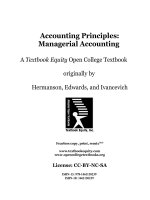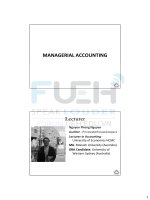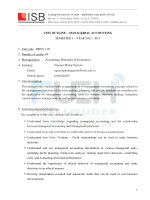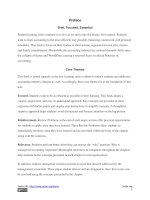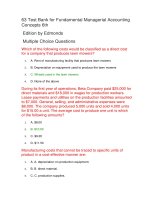running head managerial accounting
Bạn đang xem bản rút gọn của tài liệu. Xem và tải ngay bản đầy đủ của tài liệu tại đây (1.08 MB, 14 trang )
Running head: Managerial Accounting 1
Group Assignment
Group 3
Trần Kim Dự
Bùi Lê Châu Hà
Nguyễn Lê Hoàng Thiện
Phạm Vũ Thảo Trinh
Managerial Accounting
October 20
th
, 2012
Professor Nguyen Phong Nguyen
Group Assignment – Group 3 2
Task 1: CVP Analysis
Beta Corporation recently expanded its manufacturing capacity. The firm will now
be able to produce up to 22,500 units of either product C or D. The sales
department assures management that it can sell between 13,500 and 19,500
units of either product this year. Because the two products are very similar, the
company will produce only one of the two products. The following information was
compiled by the accounting department.
Product C Product D
Selling price per unit………….… $132.00 $120.00
Variable costs per unit…….….… 79.20 79.20
Fixed costs will total $554,400 if product C is produced but will be only $475,200 if
product D is produced. Beta Corporation is subject to a 40 percent income tax rate.
a. Compute the contribution margin ratios for each product.
CM
C
per unit = Price – Variable cost per unit = $132.00 - $79.20 = $52.8
CMR
C
=
=
CM
D
per unit = Price – Variable cost per unit = $120.00 - $79.20 = $40.8
CMR
D
=
=
b. If Beta Corporation desires an after-tax net income of $33,120, how many
units of product D will the company have to sell?
Target income of Beta Corporation before 40% taxes =
Number of product D sold to get $33,120 after-tax net income
=
=
c. How much would the variable cost per unit of product D have to change
before it had the same break-even units as product C?
Break-even units of product C =
Group Assignment – Group 3 3
Variable cost per unit of product D
= Price – CM’D per unit = $120.00 - $45.26 = $74.74
Δ Variable cost per unit = $79.20 - $74.74 = $4.46
The variable cost per unit of product D decreased by $4.46
d. Suppose the variable cost per unit of product D decreases by 10 percent, and
the total fixed cost of product D increases by 10 percent. Compute the new break-even
point.
Variable cost per unit of product D = 0.9 x $79.20 = $71.28
CM per unit of product D = Price – Variable cost per unit
= $120.00 - $71.28 = $48.72
Fixed cost = 1.1 x $475,200 = $522,720
Break-even units =
Break-even sales = Break-even units x Price = 10,729 x $120.00 = $1,287,480
e. Suppose the board of management decided to produce both products. If
the two products are sold in equal proportions (in the number of units), and total fixed
costs amounted to $514,800, what is the firm’s break-even point in units?
The two products are sold in equal proportions
In 1 package, there are 1 product C and 1 product D.
CM per unit = CM
C
per unit + CMR
D
per unit = $52.8 + $40.8 = $93.6
Break-even units =
The firm sales 5,500 products C and 5,500 products D.
Group Assignment – Group 3 4
Task 2: Cash Budgeted and Control
The president of the retailer Prime Products has just approached the company’s bank
with a request for a $30,000, 90-day loan. The purpose of the loan is to assit the
company in acquiring inventories. Because the company has had some difficulty in
paying off its loans in the past, the loan officer has asked fora cash budget to help
determine whether the loan should be made. The following data are available for the
months May through July, during which the loan will be used:
On May 1, the start of the loan period, the cash balance will be $24,000.
Accounts receivable on May 1 will total $140,000, of which $120,000 will be
collected during May and $16,000 will be collected during June. The remainder
will be uncollectible.
Past experience shows that 30% of a month’s sales are collected in the month of
sale, 60% in the month following sale, and 8% in the second month following
sale. The other 2% represents bad debts that are never collected. Budgeted
sales and expenses for the three-month period follow:
May
June
July
Sales ( all account)
$300,000
$400,000
$250,000
Merchandise purchases
$210,000
$160,000
$130,000
Payroll
$20,000
$20,000
$18,000
Leases payments
$22,000
$22,000
$22,000
Advertising
$60,000
$60,000
$50,000
Equipment purchases
-
-
$65,000
Deprecitaion
$15,000
$15,000
$15,000
Merchandise purchases are paid in full during the month following purchase.
Accounts payable for merchandise purchases during March, which will be paid
during May, total $140,000.
In preparing the cash budget, assume that the $30,000 loan will be made in May
and repaid in July. Interest on the loan will total $1,200.
Group Assignment – Group 3 5
a. Prepare a schedule of expected cash collections for May, June, and July, and
for the three months in total.
May June July Total
Account Receivable
May $120,000 _ _ $120,000
June _ $16,000 _ $16,000
July _ _ _ _
Total Account Receivable $120,000 $16,000 _ $136,000
Month’s Sale Collected
May
$
$294,000
June $
$360,000
July _ _ $
$75,000
Total Month’s Sale Collected $90,000 $300,000 $339,000 $729,000
Total Expected Cash Collection $210,000 $316,000 $339,000 $865,000
With :
a= (300,000*0.3= 90,000)
b= (300,000*0.6= 180,000)
c= (400,000*0.3= 120,000)
d= (300,000*0.08= 24,000)
e= (400,000*0.6= 240,000)
f= ( 250,000*0.3= 75,000)
Group Assignment – Group 3 6
b. Prepare a cash budget, by month and in total, for the three-month period.
May June July Total
Beginning cash balance $24,000 $22,000 $26,000 $72,000
Cash sales and
collection on account 210,000 316,000 339,000 865,000
Total cash available $234,000 $338,000 $365,000 $937,000
Less: Disbursements
Payment for:
Merchanise $(140,000) $(210,000) $(160,000) $(510,000)
Payroll (20,000) (20,000) (18,000) (58,000)
Lease (22,000) (22,000) (22,000) (66,000)
Advertising (60,000) (60,000) (50,000) (170,000)
Equipment _ _ (65,000) (65,000)
Total disbursement $242,000 $312,000 $315,000 $869,000
Excess (deficiency)
of cash available overneed $(8,000) $26,000 $50,000 $68,000
Financing:
Borrowings 30,000 _ _ 30,000
Repayment _ _ (30,000) (30,000)
Interest _ _ (1,200) (1,200)
Total financing $30,000 _ $(31,200) $(1,200)
Ending cash balance: $22,000 $26,000 $18,800 $66,800
c. If the company needs a minimum cash balance of $20,000 to start each month,
can the loan be repaid as planned? Explain.
The loan can not be repaid as planned, because although the company needs a
minimum cash of $20,000 to start each month, the ending cash balance of July is
18,800, so the beginning cash balance of August will be smaller than $20,000.
Therefore, in order to have $20,000 in the beginning of August, they must hold the loan,
and repay it later.
Group Assignment – Group 3 7
TASK 3: Standard Costing and Cost Variance Analysis
Rosa Corporation uses a standard-costing system to assist in the evaluation of
operation. The company has had considerable trouble in recent months with suppliers
and employees, so much so that management hired a new production supervisor
(Christ Rochester). The new supervisor has been on the job for five months and has
seemingly brought order to an otherwise chaotic situation.
The vice president of manufacturing recently commented that “… Christ has really done
the trick. The change to a new direct material supplier and Christ’s team-
building/morale-boosting training exercises have truly brought things under control”.The
vice president’s comments were based on both a plant tour, where he observed a
contentedworkforce, and a review of the following data, which was extracted from the
performance report:
Direct material variances (favorable)……………………….$9,240
Direct labor variances (favorable)………………………… 12,350
These variances are especially outstanding, given that the amounts are favorable and
small (Rosa Corporation’s budgeted material and labor costs generally each average
about $1,050,000 for similar periods). Additional data follow.
The company purchased and consumed 45,000 kilograms of direct materials at
$15.40 per kilogram, and paid $32.50 per hour for 20,900 direct labor hours of
activity. Total completed production amounted to 9,500 units.
A review of the firm’s standard cost records that each completed unit requires
4.2 kilograms of direct material at $17.60 per kilogramand 2.6 direct labor hours
at $28 per hour.
a. On the basis of the information contained in the performance report, should Rosa
Corporation be concerned about its variances? Why?
On the basic of the information contained in the performance report, Rosa Corporation
should not be concerned about its variances, because (1) as the vice president
commented, everything is under control after the change to new supplier and the moral
training exercises, (2) those variances reported are favorable and small, compared with
the $1,050,000 for each budgeted material and labor costs.
Group Assignment – Group 3 8
b. Calculate the company’s direct material variances and direct labor variances.
Direct material variances:
Direct labor variances:
c. On the basis of your answers to requirement (b), should Rosa Corporation be
AP x AQ
= $15.40 x 45,000
= $693,000
SP x AQ
= $17.60 x 45,000
= $792,000
SP x SQ
= $17.60 x (9500
x 4.2) = $702,240
Price variance
= $693,000 - $792,000
= $99,000F
Usage variance
= $792,000 - $702,240
= $89,760U
Total variance
= $99,000F + $89,760U
=$9,240F
AR x AH
= $32.50 x 20,900
= $697,250
SR x AH
= $28 x 20,900
= $585,200
SR x SH
= $28 x (9500 x
2.6) = $691,600
Rate variance
= $697,250 - $585,200
= $94,050U
Efficiency variance
= $585,200 - $691,600
= $106,400F
Total variance
= $94,050U + $106,400F
=$12,350F
Group Assignment – Group 3 9
concerned about its variances? Why?
Based on the calculation of each components, we find out that although the Direct
Material Variance is favorable, it was made of both high favorable price variance and
high unfavorable usage variance. That results raises the concern about usage variance.
Therefore, as a manager, we should take each variance into account.
Similarly, the favorable Direct Labor Variance comes from noticeably high unfavorable
rate variance and favorable efficiency variance and the manager should consider each
of them.
d. Are things going as smoothly as the vice president believes? Evaluate the
company’s variances and determine whether the change to a new supplier and
Christ’s team-building/morale-boosting training exercises appear to be working.
Explain.
As shown in the calculation, there are big problem in extremely high unfavorable
material usage variance and labor rate variance. Thus, things are not going as smoothly
as the Vice President expected.
Firstly, the change to a new supplier brings advantage in price aspect, reducing
standard price by $2.20 per unit purchased. However, under the pressure of making
favorable variances, the manager may allow to purchase materials of lower quality or
excessive inventory purchases in order to get quantity discounts. Thus, to decide
whether the change has good impact or not, the manager should revise quality of
products.
Secondly, to evaluate the impact of training exercises, we should consider the Material
usage variance , Labor rate variance as well as Labor efficiency variance. Faulty
workmanship may lead to more consumption in raw material, proved by high
unfavorable material usage variance. Deployment of more efficient and skilled workers
giving rise to higher payment, then high unfavorable rate variance. However, it is a good
news on efficiency variance, which indicated that the training courses had induced the
labor to work more effectively.
Group Assignment – Group 3 10
e. Is it possible that some of the company’s current problems lie outside Christ’s
area of responsibility? Explain.
There are many problems that may lie outside Christ’s area of responsibility.
Material price variance:
o Fluctuations in market price dues to government intervention
o Usually the responsibility of controlling price belongs to the purchasing
agent and Christ has no work in this field (M.Moen, R.Hansen & L.Heitger,
2009)
Material usage variance:
o Maintenance and purchase of plant and equipment
Labor rate variance:
o Higher payment due to shortage of availability of labor
o Extra-Shift allowance to workers overtime allowance leads to higher
wages.
o Change in the system of wage payment
o Higher rates during seasonal or emergency operations
Group Assignment – Group 3 11
Task 4: Divisional Performance Evaluation
Alpha Corporation is a multi-product company with three divisions: North Division, South
Division, and West Division. The company has two sources of long-term capital: debt
and equity. The interest rate on all Alpha Corporation’s $1,600 million debt is 9 percent,
and the company’s tax rate is 30 percent. The cost of Alpha Corporation’s equity capital
is 12 percent. In addition, the market value of the company’s equity is $2,400 million.
(The book value of Alpha Corporation’s equity is $1,720 million, but that amount does
not reflect the current value of the company’s assets or value of intangible assets).
The following data (in millions) pertain to Alpha Corporation’s three divisions.
Operating income Current liabilities Total assets
North $56 $24 $280
South 180 20 1,200
West 184 36 1,920
a. Compute Alpha Corporation’s weight-average cost of capital (WACC).
The aftertax cost of debt:
= Y * (1 – T) = 9% * (1 – 0.3) = 6.3%
= 12%
Percentage of debt in total assets:
*100% = 40%
Percentage of equity in total assets: 100% - 40% = 60%
The weigth average cost of capital: WACC = 6.3%*0.4 + 12%*0.6 = 9.72%
b. Compute the economic value added (EVA) for each of the company’s three
divisions.
Current Liabilities Total assets Capital employed
North $24 $280 $256
South $20 $1200 $1180
West $36 $1920 $1884
Group Assignment – Group 3 12
EVA = After-tax operating income – (Actual percentage cost of capital x Total capital
employed)
North:
After-tax operating income: $56 million* (1 – 0.3) = $39.2 million
EVA = $39.2 million – 0.0972*$256 million = $14.3168 million.
South:
After-tax operating income: $180 million* (1 – 0.3) = $126 million
EVA = $126 million – 0.0972*$1,180 million = $11.304 million
West:
After-tax operating income: $184 million* (1 – 0.3) = $128.8 million
EVA = $128.8 million – 0.0972*$1,884 million = ($54.3248 million)
c. What conclusion can you draw from the EVA analysis?
West division makes money less then the money it takes to make it.
South and North divisions make money more than the money they take to make it.
Seemly, the company had a best performance in North division.
d. How does EVA differ from residual income (RI)? What are the strengths and
weaknesses of EVA?
The difference between EVA and RI
The key feature of EVA is its emphasis on after-tax operating profit and the actual cost
of capital. RI, on the other hand, uses a minimum expected rate of return.
The strengths and weaknesses of EVA.
Strengths
Do not have to estimate a terminal value at some future point in time (Drake,
2003)
Can apply in situations in which the company does not pay dividends or
generate free cash flows. (Drake, 2003)
Group Assignment – Group 3 13
Consistent with economic theory and Porter’s Five Forces (Drake, 2003)
Weaknesses
Relies heavily on the availability and accuracy of accounting data (Drake, 2003)
Assumes clean surplus accounting. (Drake, 2003)
Assumes that the book value of equity is a reliable measure of owner’s equity in
the firm. (Drake, 2003)
The companies least suited for economic profit are high-growth, new-economy
and hightechnology companies, for whom assets are 'off balance sheet' or
intangible.
Group Assignment – Group 3 14
References
M.Moen, M., R.Hansen, D., & L.Heitger, D. (2009). Standard costing: A managerial
control tool. In Cornerstones of Managerial Accounting (3rd ed., p. 429, p. 433).
South-Western CENGAGE Learning.
Drake, Pamela. The analyst residual income. Pg 135. Michigan, USA,: 2003. Print.
